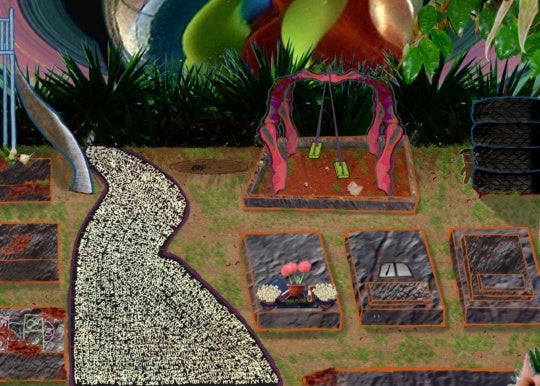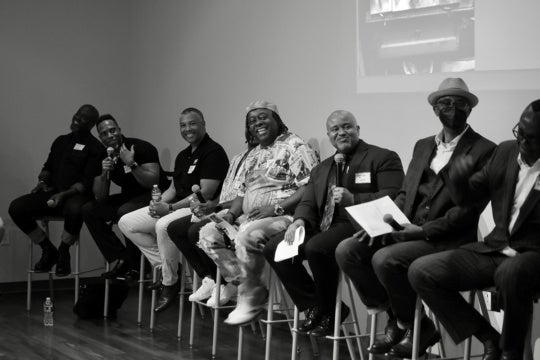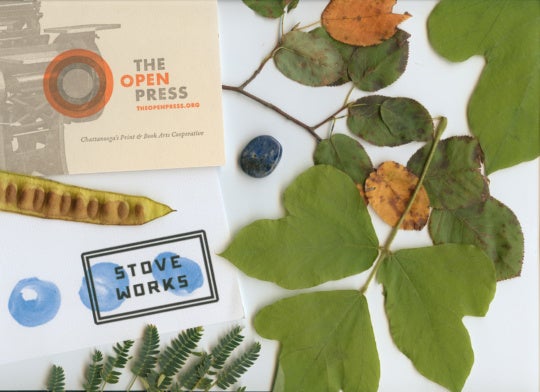
Portland artist Michael T. Hensley’s abstract paintings offer a heady blend of glee and despair. His marks are simple but their accumulation is complex. The direct process he employs gives us a great deal to look at. His exhibition “Demolition Notes” at Sandler Hudson Gallery features 10 panel paintings and six works on paper.
At first glance, one encounters a group of paintings, more or less square, ranging from 36 to 48 inches on a side. Overlapping marks are built up quite heavily on these panels. Scrawls, drips, inscriptions, brush strokes, smears, and doodles are layered upon each other. The marks are dense at the bottom of each panel and they usually thin out near the top, leaving space that evokes open sky above a heap or mound. This “sky space” is dominated by grungy, polluted whites. Hensley appears to employ a wet oil layer of white in each of his paintings at some early stage. This white layer obscures some marks, allows others to blend into it and then, upon drying, it is overlaid with additional marks. Some of his scrawls are buried by white, others cut into it, and still others lie on its surface. His various materials include artist’s paint to housepaint, pencil, pastel, and anything else handy that can leave residue on a surface.
Within this vocabulary, the separate pieces manage to develop their own unique characteristics. Half Timer involves a large number of graphite and/or charcoal scrawls, which add up to a predominately gray palette. Both painting and drawing are submerged under the dirty-white surface. Robot Sky is a straightforward occluded matrix of cross hatching. Its “sky” is almost crowded out and the buildup suggests forms that are gridlike but dilapidated. Listing buildings, sagging scaffolds, or blown-over pavilions come to mind. “Sub-Surface” is a well-balanced abstraction, where some wider strokes of saturated color take over the space. Modelo is a candy-colored jumble, a heap where large bright shapes jostle one another.

40 by 44 inches.
The six works on paper, titled Transfer 1-6, are less dense. They involve a shallower layering of marks and have an interesting mechanical connection to the larger works. Each one began as a transfer matrix. Hensley applied paint to paper, then applied paper to panel somewhat like a stamp. It is hard to guess how many of these transfers Hensley used, but he seems to have selected a small number, and perhaps has built them up slightly to become works of their own.
The scrawls in these paintings are reminiscent of Cy Twombly’s systems of repeated marks. Go Joe is a work that makes this resemblance especially striking. Hensley’s scrawls, however, seem less austere and more emotional than Twombly’s. The title of the show, “Demolition Notes,” refers to the literal demolition of Hensley’s studio, which was impending as he created the work. He also cites personal losses as an influence. With this knowledge, we can easily interpret Hensley’s marks as evocative.
Phillip Guston might be even more pertinent to Hensley’s paintings than Twombly. Guston depended heavily on whites that were soiled with ashen colors or dulled reds. He utilized the bubbly infantile shapes of populist cartooning in conjunction with this palette, and achieved a strange affect of despair. Hensley is much more abstract and his palette includes hyper-saturated colors that Guston never used, but he evokes a similar type of despair as he employs tainted whites and bubbly, pop-derived shapes.

Imagery does flicker in and out of Hensley’s paintings. The compositions all vaguely suggest mounds, heaps or hills. Within these heaps brick walls, dialog balloons, and vague cartoon heads materialize. Amid the scrawls of Typo Writer, a man sits hunched over with a blue cartoon teardrop springing from his face. A wobbly drawing of a woman in a bathing suit reclines nearby. Segments of brick wall proliferate. A fainter white teardrop dangles pendulously from the man’s anus.
It would be unproductive to focus too much on the occasional images that can be identified in Hensley’s paintings. However, they do clue us in to his interests. Hensley is interested in the language of refuse and debris. The mound can be a mound of rubble, the heap a heap of refuse, the hill a hill of detritus. His white space is crowded out as things pile into it haphazardly, leaving stains and traces that are Guston-bleak. Titles like 2 am-er and Slurveyor tune us in further to the artist’s slough of despair.
There is glee in the work as well. Hensley’s colors are vibrant and playful, the movement of his marks capricious. Under an initial emotional read we can see that he is interested in operating aesthetically. Popular beauty often carries with it the dross of sentimentality and convention. Historically artists have used pain, or mortality, or darkness to distill beauty- if not purifying it then at least relieving it of its unnecessary elements. As he expresses his despair, Hensley burns away a clear space in which he sets to work crafting something beautiful.
“Demolition Notes” is an exhibition that strikes some interesting balances. Hensley’s language is simplified, but he uses it to generate complex phenomena. Both emotions and aesthetics are balanced through opposition in these intriguing works.
Orion Wertz is a painter and graphic novelist living in Columbus, Georgia. He is a professor at Columbus State University, where he teaches drawing and painting. He was a finalist for the 2015 Hudgens Prize.




